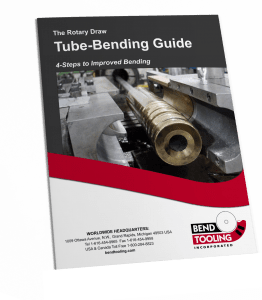In rotary-draw tube-bending the tools make the bend. Small variations or errors in the design, manufacture, or set-up of rotary-draw tools can lead to loss of process control, poor bend quality, abbreviated tool life, and other headaches.
This includes the wiper die. At first blush it is a simple tool. Often the wiper is a solid block machined to fit the gap between the bend die and the back tangent of the tube to be bent. Frequently the wiper die is an uncomplicated two-piece assembly in which the leading edge of the tool is a disposable insert. Other than size and material, there doesn’t appear to be much to the specification of a wiper die. Looks are deceiving.
The essential element of wiper die design is the feathered edge, so called because it is the sharp knife-like edge formed by the convergence of the tube cavity with the sweep of the radius face. The rest of the tool is nothing but mass to support the feathered edge and to provide sufficient surface area for mounting to the tube-bending machine. The geometry of the feathered edge is not as simple or obvious as it may appear. Precisely how this intersection of the tube cavity and the radius face is machined into a wiper has the primary impact upon the tool’s performance.
Before examining that issue, it will be useful to review the purpose of a wiper die. It serves two functions in the rotary-draw process. The first is to prevent a hump from forming at the trailing end of the inside radius of the tube bend. As the tube is being drawn into the bend, it becomes plasticized at the point of bend. The plasticized material behind the line of tangency flows into the curve of the bend die cavity that is sweeping away from the back tangent of the tube. Upon completion of the draw, if this deformation exceeds the elasticity of the tubing material, it will set as a hump, or a series of small humps, at the end of the bend. Fixturing a wiper die in the gap between the bend die and the tube stops the deformation from reaching that point by blocking the flow of the material into that gap.
Because all tubing materials have some elasticity – i.e., the property of resuming its original shape when stress is relieved – it is not necessary to fixture a wiper so that it fills the entire gap to prevent the formation of a terminal hump. A wiper can be raked – the angling of the feathered edge away from the line of tangency – so that it blocks no more than the flow of material before it exceeds its elasticity. The advantage of doing so is longer tool life. If you examine a worn wiper die that was set at little or no rake, you will observe that the tube cavity immediately behind the feathered edge is dished out from blocking the entire flow of material. This dishing cuts the life of a wiper die.
However, raking a wiper die to extend its life can be at odds with its second function: Full containment of the tubing material at the point of bend when bending under high pressure. Normally, high radial pressure as applied by the pressure die is not necessary in most draw-bending applications, especially if the mandrel nose is used aggressively. However, higher pressures cannot be avoided for bending materials such as 304 stainless steel or titanium – or even mild steel on an extremely tight centerline radius. These materials resist the compression that occurs as the intrados of the tube bend thickens during the draw. If the flow of material is not completely contained by tooling at the point of bend – the mandrel inside in the tube, the pressure die over the outside radius of the bend, the bend die over the inside radius ahead of the line of tangency, and the wiper set at zero-rake over the inside radius behind it – the compression will buckle the tube.
Therefore, tubing material (and to a lesser extent, bend specifications) will dictate whether or not a wiper can be raked. Those same factors also dictate the geometry of the feathered edge. In low-pressure bending in which elimination of the terminal hump is the only consideration and so the wiper can be raked, a simple-sweep geometry will suffice. In high-pressure bending in which the wiper must function as a backstop to the force of the pressure die and so the wiper must be set at zero-rake, an offset geometry is needed.
It is important to know that the simple-sweep feathered edge for low-pressure bending will not work well for high-pressure bending, and vice versa for the offset feathered edge. However, most suppliers of wiper tooling manufacture their wipers only with some variation of the simple-sweep geometry – i.e., the edge formed by the convergence of wiper’s tube cavity with its radius face. The exact geometry is usually determined not by how the wiper is to be used, but rather ease of manufacture. Even though the technology now exists to precision machine a feathered edge to completion, most simple-sweep feathered edges are at least partly made by manual honing or sanding. This creates even wider variations in the finished tool.
Often the end-user of hand-finished wipers partly compensates for discrepant feathered-edge geometry in two ways. First is by adjusting the rake. Second is by using aluminum-bronze as the material for the wiper to wear-in the desired feathered-edge geometry. However, both of these remedies work against process control in rotary-draw bending, because they are inherently variable or worse, unstable, and defeat attempts to standardize set-up parameters for a given tube-bending application. Bend Tooling has responded this problem by fully precision-machining to finish specifications the feathered edge, which entirely eliminates the variability of hand-finished wipers. (The photo below contrasts the quality of hand-finished feathered edges of wiper from a North American and a European tooling supplier with the fully precision-machined feathered edge of a Bend Tooling wiper shown above.)
However, even a fully precision-machined simple-sweep feathered edge is unsuited for a wiper set at zero-rake for high-pressure bending. To address this, Bend Tooling developed the offset feathered edge, called the Aero-Cut™. With the proper offset between the tube cavity and the radius face machined into the wiper die, the Aero-Cut™ feathered edge will maintain its integrity at the point of bend and provide sufficient containment of the material without deeply marking it. (In addition to this, Bend Tooling has also introduced a high-pressure wiper system specially designed from end-to-end for use at zero-rake under high radial and axial pressures. This new tool combines the best features of solid-body and inserted wipers while reducing the per-bend cost. Contact us for details.)
Fortunately, you can completely control what you get in a wiper die from your tooling supplier by taking into account the following design and manufacturing considerations of the feathered edge when specifying a wiper die:
• First is the material of the wiper. The non-nickel aluminum-bronzes remain the superior choice for steel, stainless steel, and titanium tubing. Untreated leaded steels are best for non-ferrous tubing. Harder materials, heat treatment, and coatings tend to make the feathered edge like an eggshell and lead to pre-mature failure as it fractures.
• Second is the geometry of the feathered edge. If the wiper will be raked, then simple-sweep geometry is required. If the wiper will be set at zero-rake to accommodate high-pressure bending of stainless steel, titanium, Inconel, or other similar tubing materials, then the feathered edge must have offset geometry.
• Finally, ensure that the feather edge is completely manufactured by machine. The feathered edge is a precision attribute of a wiper. If it is finished by manual methods, the soundness of its design will be compromised by the unavoidably wide variations in its manufacture by hand. Always insist upon a fully machined feathered edge.

